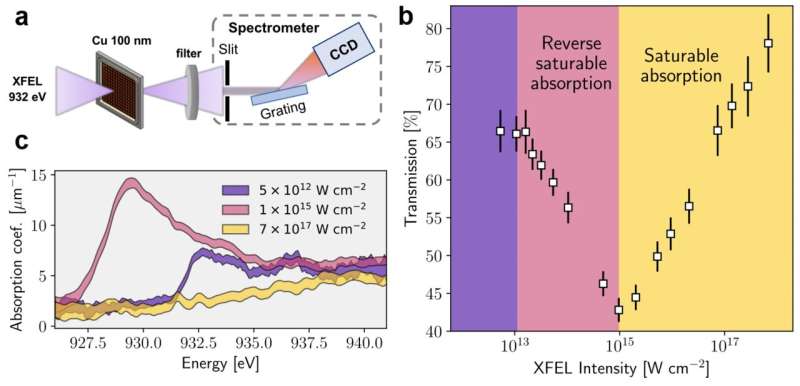
Diagram of the experimental device and results. Credit: European XFEL; Laurent Mercadier
The experiments conducted at the European XFEL laboratory generate states of matter close to those observed inside planets or in the imploding capsule of an inertial fusion reactor. At the same time, they open the way to the measurement of ultra-short phenomena.
Exploring the extreme conditions found inside planets, including Earth, or during fusion reactions, is a major challenge. By focusing the European XFEL’s extremely powerful X-ray laser onto a copper foil, researchers have created and studied a far-from-equilibrium state of matter, called hot dense matter (WDM), that resembles these exotic environments.
Their results represent remarkable progress in understanding and characterizing this elusive state of matter, which is crucial for advancing inertial confinement fusion, a promising process for clean and abundant energy. The research is published in the journal Physics of nature.
Heat can radically change the state of matter. Depending on the temperature, substances are solid, liquid or gaseous. Within a certain temperature range, matter also takes on a state called hot dense matter (WDM): it is too hot to be described by condensed matter physics, but at the same time too dense for weakly coupled plasma physics.
The boundary between hot dense matter and other states of matter is not precisely defined. A temperature range of 5,000 to 100,000 kelvins for pressures of several hundred thousand bars is often defined, with one bar corresponding to the atmospheric pressure at the Earth’s surface.
WDM is not stable in our everyday environment and is very difficult to produce or even examine in the laboratory. Typically, scientists compress samples in diamond anvil cells to achieve high pressures, or use powerful optical lasers to transform solids into WDM in a tiny fraction of a second.
Intense X-ray pulses from the European XFEL telescope have proven to be a very useful tool for generating and analyzing hot, dense matter. The researchers used copper as the sample material. “The high intensity of the pulses can excite the electrons in the copper foil to such an extent that it becomes a hot, dense matter,” explains Laurent Mercadier, the SCS instrument scientist who led the experiment. “This results in a change in its light transmission.”
A metal irradiated by an intense X-ray pulse can become transparent if the electrons in the metal absorb the X-ray energy so quickly that there are no electrons left to excite. The remaining tail of the pulse can then penetrate the material unimpeded. This is called saturable absorption (SA).
Conversely, a metal can become increasingly opaque if the front part of the pulse creates excited states that have a higher absorption coefficient than the cold metal. The tail of the pulse is then absorbed more strongly, an effect known as inverse saturable absorption (RSA). Both of these processes are commonly used in optics, for example to generate a specific pulse length with lasers.
Researchers at the European XFEL irradiated focused 15-femtosecond X-ray pulses onto a 100-nanometer-thick copper film. They then analyzed the transmitted signal using a spectrometer.
“The spectrum depends strongly on the intensity of the X-ray pulse,” Mercadier explains. “At low to moderate X-ray intensities, the copper becomes increasingly opaque to the X-ray beam and exhibits RSA. However, at higher intensities, the absorption saturates and the foil becomes transparent.”
These drastic changes in opacity occur so quickly that the atomic nuclei of the metal do not have time to move. “We are dealing with a very exotic state of matter where the lattice is cold and some of the ionized electrons are hot and are not in equilibrium with the remaining free electrons of the metal,” Mercadier explains.
“To explain this phenomenon, we developed a theory that combines solid-state and plasma physics.” For the researchers, this change in opacity is a sign that they have succeeded in creating and characterizing dense, hot matter in the laboratory.
Understanding the opacity of materials under these extreme conditions is urgent for inertial confinement fusion. In the latter case, intense energy is used to compress and heat a combustible target, creating the conditions necessary for fusion. Opacity determines the amount of radiation energy absorbed or transmitted through the material, which is essential to ensure that the energy used for compression does not escape, thus enabling efficient fusion reactions.
Short is not short enough
“In fact, these effects occur so rapidly that we need even shorter X-ray pulses to completely resolve the electron dynamics,” says Andreas Scherz, SCS instrument scientist. “Recently, the European XFEL demonstrated its ability to generate attosecond pulses, paving the way for so-called attosecond physics.”
With X-ray pulses in the attosecond range, it would be possible to precisely “film” the movement of electrons during the formation of dense, hot matter or during chemical reactions, and thus significantly improve our understanding of, for example, chemical processes or the functioning of catalysts.
The 2023 Nobel Prizes in Physics awarded to the French-Swedish physicist Anne L’Huillier, the Hungarian-Austrian physicist Ferenc Krausz and the French-American physicist Pierre Agostini show that this is an extremely current research topic.
More information:
Laurent Mercadier et al, Transient absorption of hot dense matter created by an X-ray free electron laser, Physics of nature (2024). DOI: 10.1038/s41567-024-02587-w
Provided by European XFEL
Quote:When copper becomes transparent: European XFEL creates exotic matter (2024, July 29) retrieved July 30, 2024 from https://phys.org/news/2024-07-copper-transparent-european-xfel-exotic.html
This document is subject to copyright. Apart from any fair dealing for the purpose of private study or research, no part may be reproduced without written permission. The content is provided for informational purposes only.